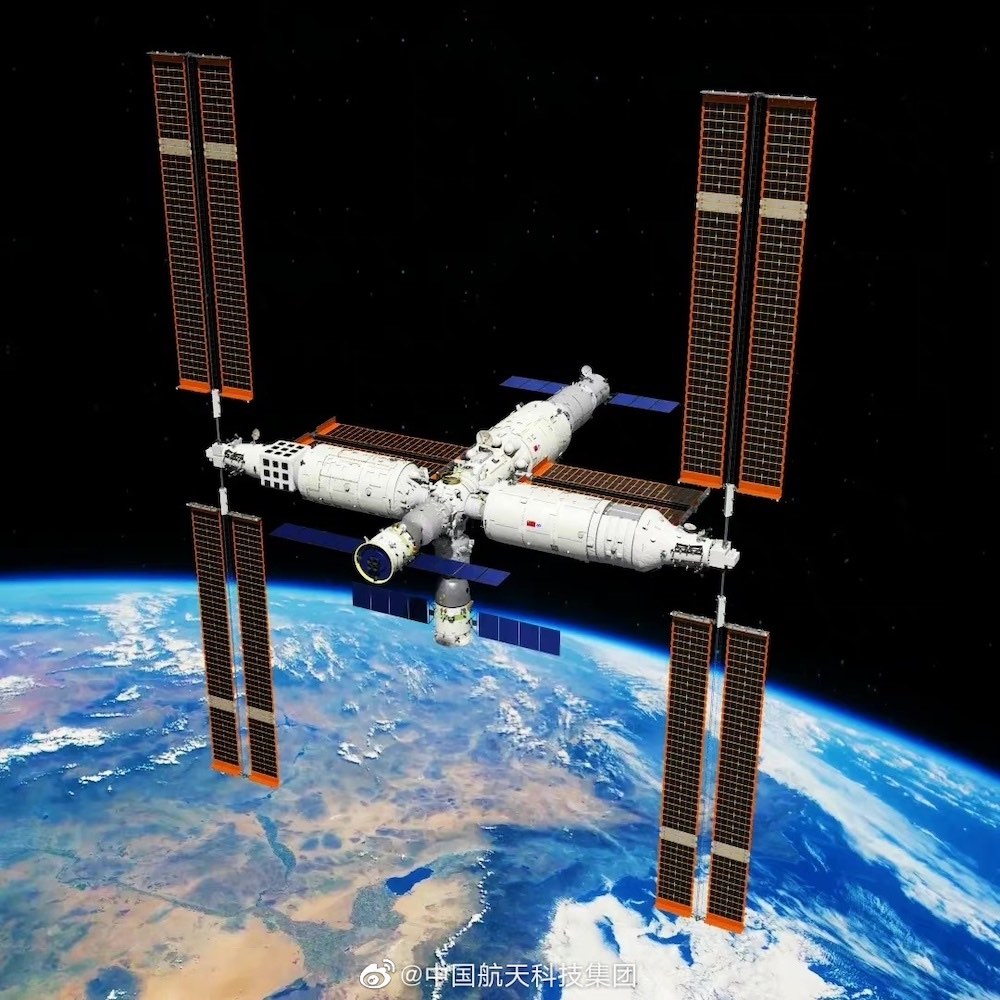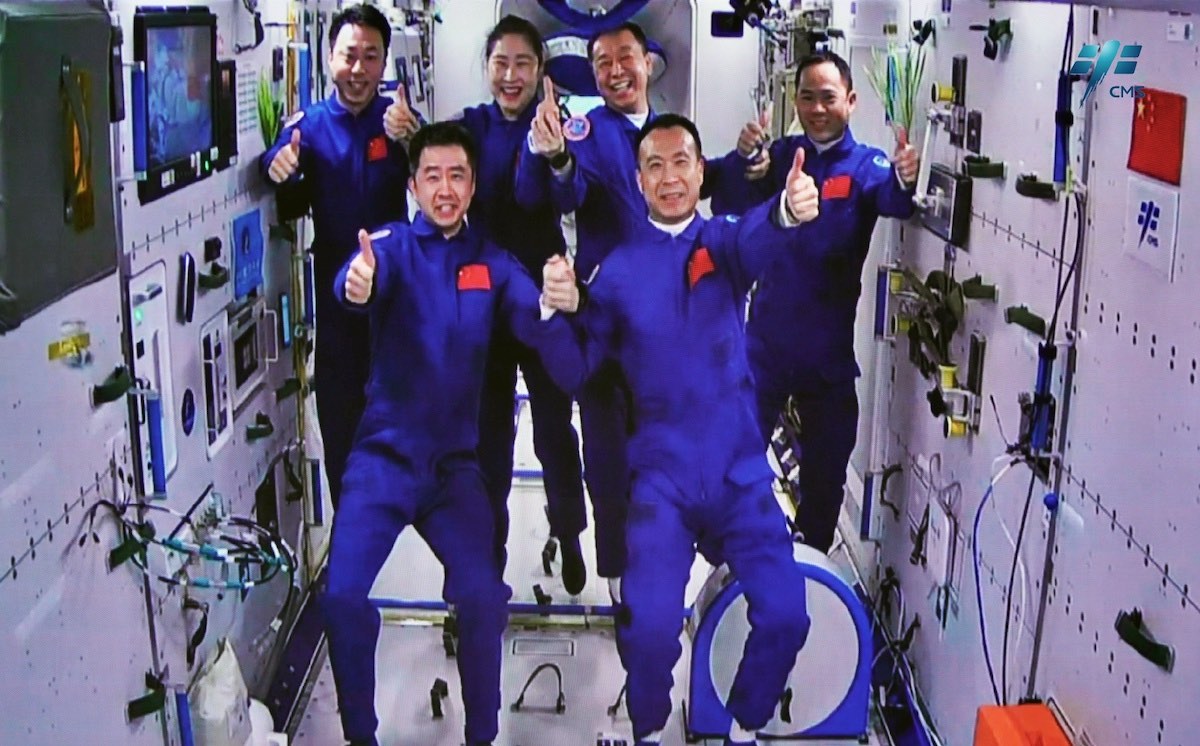
Three Chinese astronauts landed Sunday after 182 days on China’s Tiangong space station, completing the busiest mission yet for the country’s human spaceflight program. The astronauts performed three spacewalks and assisted in the arrival and outfitting of two new lab modules at the Tiangong outpost.
The Shenzhou 14 crew capsule landed under a parachute in the Inner Mongolia region of northwestern China at 7:09 a.m. EST Friday (1209 GMT) Sunday, about nine hours after undocking from the Tiangong space station about 240 miles (390 kilometers) above Earth.
The spacecraft brought home commander Chen Dong and astronauts Liu Yang and Cai Xuzhe to the remote Dongfeng landing zone in the Gobi Desert, where landing occurred in darkness. Chinese recovery teams converged on the crew capsule, which landed on its side, to open the hatch and help the astronauts out of the spacecraft.
Team members carried each of the astronauts to a chair near the capsule for brief remarks on Chinese state television, then carried them to nearby vehicles for medical checks as the astronauts re-acclimate to gravity after six months in orbit. An aircraft later flew the astronauts to Beijing to be reunited with their families.
According to the China Manned Space Agency, the astronauts were in “good health” following the landing.
Shenzhou 14 is back on Earth with Chen Dong, Liu Yang, and Cai Xuzhe after 182 days in orbit.
They oversaw the expansion of China’s space station with the arrival of two large new lab modules.
An infrared view shows the flash of the landing thrusters.https://t.co/xh1AZagPdo pic.twitter.com/H7zbTcDCon
— Spaceflight Now (@SpaceflightNow) December 4, 2022
The Shenzhou 14 spacecraft undocked from the nadir, or Earth-facing, port on the Tiangong space station’s Tianhe core module at 10:01 p.m. EST Saturday (0301 GMT Sunday) to begin the approximately nine-hour flight back to Earth.
The undocking ended five days of joint operations on the space station with the three-man Shenzhou 15 crew, which launched and docked at the complex Nov. 29. It was the first time six Chinese astronauts were in orbit at the same time, and marked the first crew handover on-board the Tiangong space station. The on-board crew handovers will become a regular occurrence every six months through the life of the Tiangong complex, allowing China to maintain a constant human presence in low Earth orbit.
Multinational crews have continuously lived and worked on the International Space Station since 2000.

The Shenzhou 14 astronauts were present at the Tiangong space station for the arrival of two major new modules — the Wentian and Mengtian laboratories — that tripled the size of the outpost. China launched the Wentian science lab July 24, then the Mengtian module Oct. 31. The modules initially docked with the forward port of the station’s Tianhe core module, then were moved to radial ports using a robotic arm to give the Tiangong outpost a distinctive “T” shape.
The astronauts also performed three spacewalks to outfit the Tiangong space station and prepare it for normal operations, and were aboard the complex for the docking of the the unpiloted Tianzhou 5 cargo ship to the space station Nov. 12.
“They witnessed many historical moments of China’s manned spaceflights,” said Ji Qiming, assistant to the director of the China Manned Space Agency.
The Shenzhou 14 mission launched June 4 (U.S. time) and docked with the Tianhe core module about seven hours later. They replaced the Shenzhou 13 crew, which departed the Tiangong station in April after six months in orbit.
After departing the Tiangong station, the Shenzhou 14 spacecraft fired thrusters to move a safe distance from the space station, then jettisoned its orbital habitation module, which will remain in orbit until aerodynamic drag pulls it back into the atmosphere. The ship’s engines then fired for a deorbit burn to slow down for re-entry, then Shenzhou’s propulsion module separated, leaving the landing capsule to bring the three astronauts back to Earth.
The re-entry capsule, protected by a heat shield, encountered temperatures of several thousands degrees. After a brief build-up in G forces, the spacecraft deployed a nearly 13,000-square-foot (1,200-square meter) main parachute to slow its descent for touchdown at the Dongfeng landing site.
Soft landing rockets ignited just before touchdown to cushion the impact for the three astronauts.

The Shenzhou 14 landing craft appeared to suffer one anomaly after landing, when the capsule failed to release its main parachute line. Previous Chinese spacecraft have severed the parachute line just after touchdown to keep the capsule from being dragged across the ground by wind. The recovery team at the landing site was seen cutting the parachute line with a knife in a live broadcast on Chinese state television.
Chen Dong, the Shenzhou 14 commander, completed its second mission to space. He has logged 214 days in orbit, more than any other Chinese astronaut. Liu Yang, who became the first Chinese woman in space in 2012, also closed out her second spaceflight. Shenzhou 14 was the first space mission for Cai Xuzhe.
All three astronauts are former Chinese Air Force pilots.
In brief remarks after landing, Liu said she is “very happy to see my family members and also my friends. China’s space station will always meet your expectations.”
“For six months, I really experienced this glorious view,” Cai said. “And I hope I come back to our home in space one day.”
Shenzhou 14 was the ninth crewed spaceflight in China’s space program, and the third crew mission to China’s new Tiangong space station.
Email the author.
Follow Stephen Clark on Twitter: @StephenClark1.
